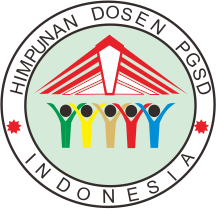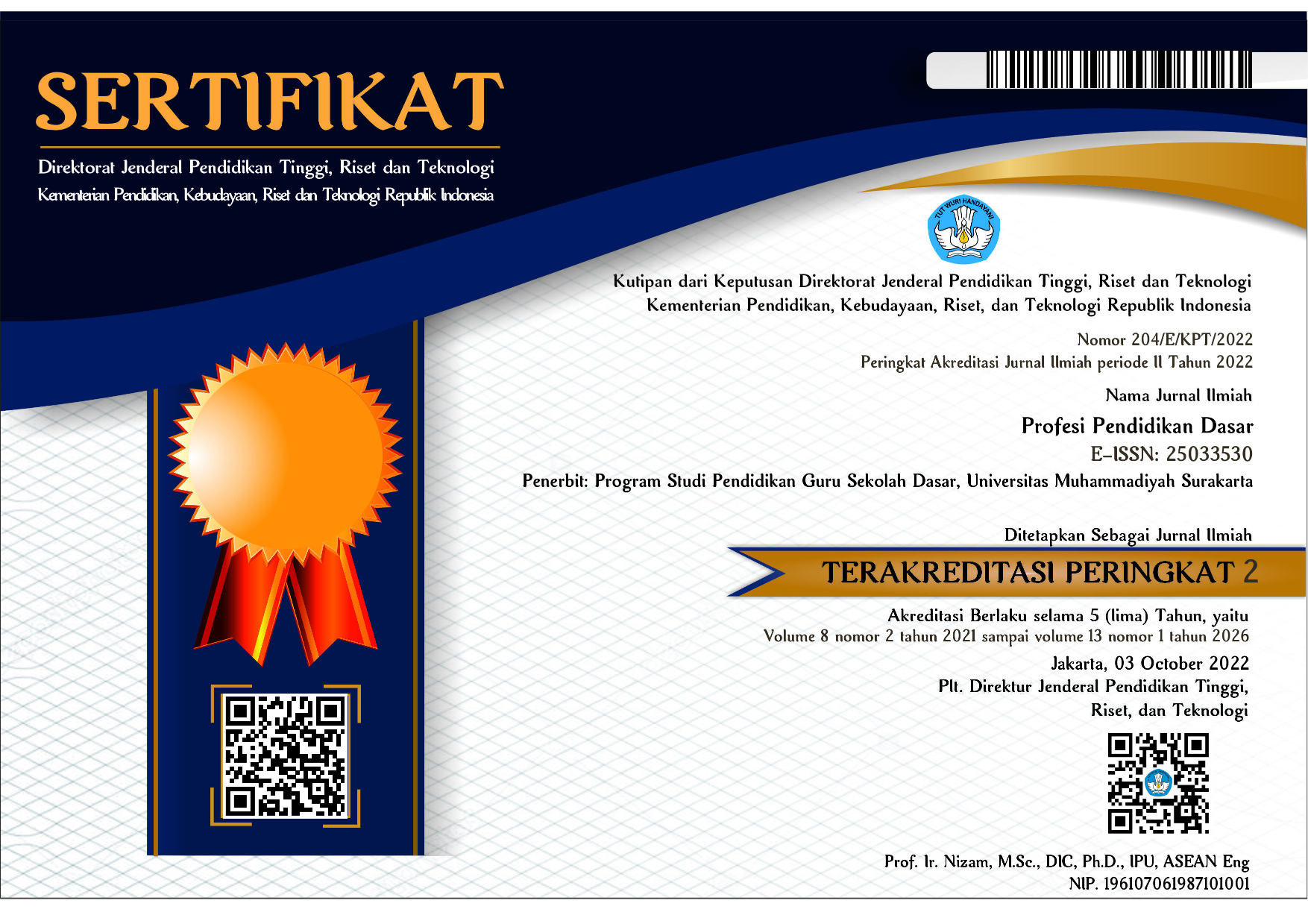Strategi Think Pair Share dan Jigsaw: Manakah yang Lebih Efektif untuk Kemampuan Pemecahan Masalah Siswa?
Arief Cahyo Utomo(1*), Zaenal Abidin(2), Henry Aditia Rigianti(3)(1) Universitas Muhammadiyah Surakarta
(2) Universitas Muhammadiyah Surakarta
(3) Universitas PGRI Yogyakarta
(*) Corresponding Author
Abstract
Keywords
Full Text:
PDFReferences
Aronson, Elliot, dan Diane Bridgeman. (1979). “Jigsaw Groups dan The Desegregated Classroom: In Pursuit of Common Goals.” Personality dan Social Psychology Bulletin 5(4): 438–46. http://journals.sagepub.com/doi/10.1177/014616727900500405.
Dimyati dan Mudjiono. (2013). Belajar dan pembelajaran. Jakarta: Rineka Cipta.
Gok, Tolga. (2018). “The Evaluation of Conceptual Learning dan Epistemological Beliefs on Physics Learning by Think-Pair-Share.” Journal of Education in Science, Environment dan Health 4(1): 69–80.DOI: 10.21891/jeseh.387489
Hedeen, Timothy. (2003). “The Reverse Jigsaw: A Process of Cooperative Learning dan Discussion.” Teaching Sociology 31(3): 325–32.DOI 10.2307/3211330
Husna et al. (2013). “Peningkatan Kemampuan Pemecahan Masalah Dan Komunikasi Matematis Siswa Sekolah Menengah Pertama Melalui Model Pembelajaran Kooperatif Tipe Think-Pair-Share (Tps) Magister Pendidikan Matematika Program Pascasarjana Unsyiah Banda Aceh 2).” Jurnal Peluang. http://jurnal.unsyiah.ac.id/peluang/article/view/1061/997
Johnson, David W., dan Roger T. Johnson. (1999). “Making Cooperative Learning Work.” Theory into Practice 38(2): 67–73. DOI: 10.1080/00405849909543834
Kothiyal, Aditi, Rwitajit Majumdar, Sahana Murthy, dan Sridhar Iyer. (2013). “Effect of Think-Pair-Share in a Large CS1 Class: 83% Sustained Engagement.” ICER 2013 - Proceedings of the 2013 ACM Conference on International Computing Education Research: 137–44.DOI: 10.1145/2493394.2493408
Kusuma, Ardi Wira. (2018). “Meningkatkan Kerjasama Siswa Dengan Metode Jigsaw.” Konselor 7(1): 26–30. DOI: 10.24036/02018718458-0-00
Liao, Soohyun Nam, William G. Griswold, dan Leo Porter. (2018). “Classroom Experience Report on Jigsaw Learning.” Annual Conference on Innovation dan Technology in Computer Science Education, ITiCSE: 302–7.DOI: 10.1145/3197091.3197118
Martalena. (2016). “Meningkatkan Hasil Belajar Matematika Siswa Siswa Kelas V Melalui Penerapan Model Pembelajaran Kooperatif Tipe Jigsaw.” Jurnal Educatio 2(1): 52–58.DOI: 10.29210/12016232
Martha, Chianson, O’kwu Emmanuel, dan Kurumeh Seraphina. (2015). “Effect of Think-Pair-Share Strategy on Secondary School Mathematics Students’ Achievement dan Academic Self-Esteem in Fractions.” Aijcsr 2(2): 141–47.http://www.aijcsr.com/index.php/aij/article/view/71
Mattingly, Robert M, dan Ronald L Vansickle. (1991). “The Attainment Of Social Studies With A Jigsaw Type Cooperative Learning Model.” Journal Resume 22(33): 348–267.http://eric.ed.gov/?id=ED348267
Rifa’i, A., dan H. P. Lestari. (2018). “The Effect of Think Pair Share (TPS) Using Scientific Approach on Students’ Self-Confidence dan Mathematical Problem-Solving.” In Journal of Physics: Conference Series,.DOI: 10.1088/1742-6596/9983/1/012084
Schoenfeld, Alan H. (2016). “Learning to Think Mathematically: Problem Solving, Metacognition, dan Sense Making in Mathematics (Reprint).” Journal of Education 196(2): 1–38.DOI: 10.1177/002205741619600202
Tamah, Siti Mina. (2007). “Jigsaw Technique In Reading Class Of Young Learners: Revealing Students’ Interaction.” Online Submission. http://repository.uksw.edu/handle/123456789/107
Tint, San San, dan Ei Ei Nyunt. (2015). “Collaborative Learning with Think-Pair -Share Technique.” Computer Applications: An International Journal 2(1): 1–11.DOI: 10.5121/caij.2015.2101
Umam, Syaiful Rohim dan Khoerul. (2019). “The Effect Of Problem-Posing dan Think-Pair-Share Learning Models On Students’ Mathematical Problem-Solving Skills dan Mathematical Communication Skills.” 4(3): 287–91.DOI: 10.26737/jetl.v4i2.803
Mulyadi dan Risminawati. (2012). Model – model Pembelajaran Inovatif di Sekolah Dasar. Surakarta : BP – FKIP UMS.
Surtikanti dan Joko Santoso. (2009). Strategi Belajar Mengajar. Surakarta: BP-FKIP UMS.
Yanti. (2014). “Peningkatan Keaktifan Dalam Hasil pemecahan masalah Materi Lingkungan Alam Dan Buatan Melalui Metode Problem Based Intruction (PBI) Pada Siswa Kelas III Semester I SDN 3 Grobogan Tahun Pelajaran 2013/2014”. Skripsi. Surakarta:FKIP UMS (tidak diterbitkan).
Zaini dkk. (2007). Staretgi Pembelajaran. Yogyakarta: CTSD (Center for Teaching Staff Development).
Article Metrics
Abstract view(s): 790 time(s)PDF: 582 time(s)
Refbacks
- There are currently no refbacks.


















